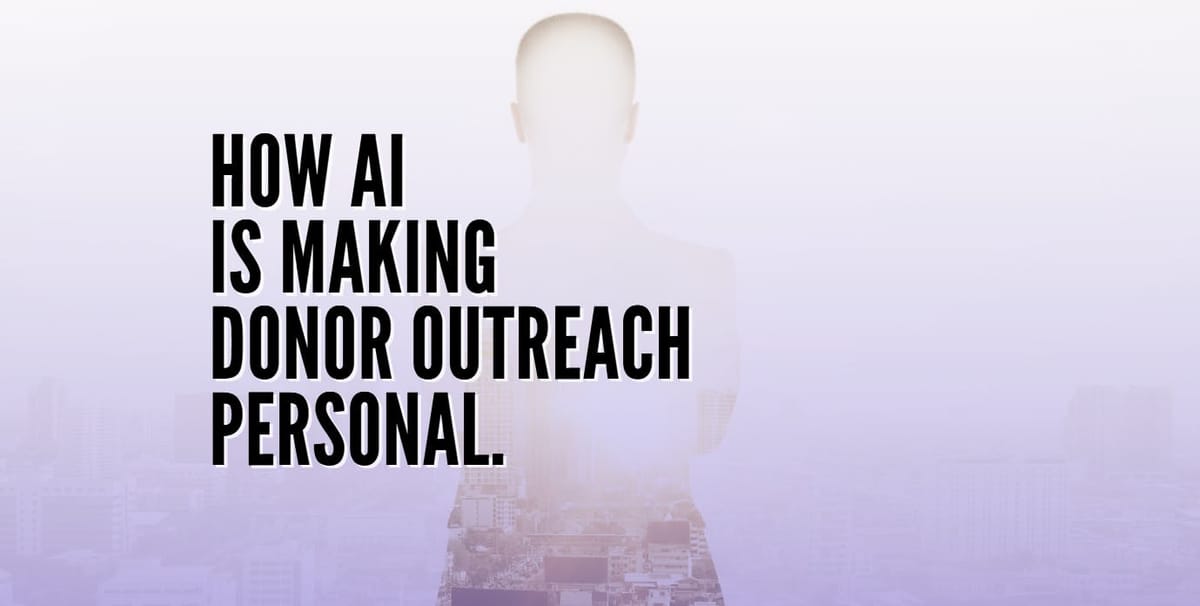The Future of Fundraising: 5 Trends Reshaping Nonprofit Donor Relationships in 2025
Explore five trends reshaping nonprofit fundraising in 2025, from AI personalization to local-focused campaigns, and learn how to build lasting donor relationships.

Nonprofit fundraising is changing fast. Here's what you need to know for 2025:
- AI-Powered Personalization: Smart donor grouping and predictive giving
- Small-Scale Sponsorships: Micro-donations with big impact
- VR/AR Storytelling: Immersive experiences driving donations
- Crypto Donations: Tapping into younger, wealthier donors
- Local-Focused Campaigns: Community-centric fundraising on the rise
Why this matters: 70.6% of donors only give once. But monthly giving programs have a 90% retention rate. The key? Building lasting connections.
| Trend | Key Benefit |
|---|---|
| AI Personalization | Targeted outreach |
| Small Sponsorships | Support local groups |
| VR/AR Storytelling | Emotional engagement |
| Crypto Donations | Access new donors |
| Local Campaigns | Community empowerment |
Bottom line: It's not just about raising money. It's about making a real impact. Nonprofits that embrace these trends and focus on strong donor relationships will thrive in 2025.
Related video from YouTube
Using AI to Personalize Donor Outreach
AI is shaking up how nonprofits connect with donors. It's not just about asking for cash anymore - it's about building real relationships.
Here's the scoop on how AI is making donor outreach personal:
Smarter Donor Grouping
AI digs into donor data to group similar folks together. This lets nonprofits craft messages that hit home for each group.
Take the American Cancer Society. They used machine learning in 2022 and BAM! Their campaign pulled in 117% more than expected. Even better? Nearly 70% of donors stuck around.
Predicting Who'll Give (and When)
AI can guess who's likely to open their wallet, how much they'll give, and when. This helps nonprofits zero in on the right donors at the right time.
Parkinson's UK gave this a shot. They used AI to pinpoint 70,000 people in their database for targeted outreach. The result? An extra £500,000 in donations. Not too shabby!
Personal Messages, Big Scale
AI writing tools can whip up emails, social posts, and campaign slogans that speak to each donor. It's a time-saver that makes donors feel special.
"AI can boost philanthropic outcomes and, in the end, help fulfill missions better." - Ashutosh Nandeshwar, SVP of data science and analytics for CCS Fundraising
Always-On Donor Support
AI chatbots can field donor questions 24/7. This keeps donors in the loop and makes giving a breeze.
Supercharging Email Campaigns
A Kid's Place Tampa Bay saw their email open rates jump from 15-20% to 37% after using AI for marketing automation. That's a lot more eyeballs on their message!
| AI Feature | What It Does |
|---|---|
| Donor Grouping | Targets outreach |
| Behavior Prediction | Times asks better |
| Personal Messages | Boosts engagement |
| AI Chatbots | Answers questions anytime |
| Email Optimization | Gets more emails opened |
2. Growth of Small-Scale Sponsorship Programs
Small-scale sponsorship programs are booming in the nonprofit world. They're changing the game by letting donors make a big splash with smaller, targeted contributions.
Micro-Sponsorships: Small Donations, Big Results
Micro-sponsorships are filling a crucial gap:
- Companies spread one big donation across many small nonprofits
- Instead of $50,000 to one group, it's $250-$1,000 to 50-200 local orgs
- No strings attached, just general funds and some marketing perks
This approach is a lifeline for the 100,000+ nonprofits with budgets under $100,000. And it's timely - nearly 65,000 new nonprofits emerged between 2010 and 2020!
Child Sponsorship: Scaling Up Impact
Child sponsorship is getting a major upgrade:
- Convoy of Hope: From feeding 20,000 kids in 2009 to 571,000 in 2023
- Their goal? 1 million daily school meals by 2030
- World Vision: Helped over 3.2 million kids through sponsorships in 2021
Community-Focused Giving: Strength in Numbers
The trend is shifting from one-on-one to community-wide support:
- Donors pool funds for broader impact
- Unbound: Helped 280,000 kids and elders in 2021
- They channeled $124.8 million directly to local projects
Sponsorship Options: Something for Everyone
Nonprofits are getting creative with giving options. Here's an example:
| Option | What You Get | Price |
|---|---|---|
| #1 | 1 Sponsored Post + 2 Promoted Resources | $1,950 |
| #2 | 1 Sponsored Post + 3 Promoted Resources | $2,500 |
| #3 | 2 Sponsored Posts + 4 Promoted Resources | $3,600 |
| #4 | 2 Sponsored Posts + 6 Promoted Resources | $4,600 |
| #5 | 3 Sponsored Posts + 12 Promoted Resources | $8,250 |
These posts can attract 2,000-6,000 visitors over a year - not too shabby for targeted outreach!
Why It's Working
Small-scale sponsorships are taking off because they're:
- Budget-friendly for donors
- Supporting overlooked local groups
- Creating personal connections
- Showing clear, measurable results
As we approach 2025, expect these focused, impactful giving options to keep growing. They're reshaping donor-nonprofit relationships, one small contribution at a time.
3. VR and AR in Nonprofit Storytelling
VR and AR are shaking up how nonprofits connect with donors. These tools create experiences that make causes feel real and immediate.
VR: Walk a Mile in Their Shoes
VR doesn't just show - it makes you feel. The National Autistic Society's "Too Much Information" VR puts you in an autistic child's world during a shopping trip. It's sensory overload, up close and personal.
Alzheimer's Research UK did something similar. Their "A Walk Through Dementia" app lets you see life through a patient's eyes. It's eye-opening stuff.
AR: Your Cause, Right Here
AR brings your message to life, often through a smartphone. The World Wildlife Fund used AR to let people "meet" endangered Caucasian leopards in busy areas. It worked - over 100,000 people engaged, leading to new protected areas.
The NHS got creative with blood donation. They used AR billboards to show people what donating looks like. It made the process less scary and more real.
Does It Work? You Bet
These aren't just cool toys. They drive real results. charity: water used VR at a fundraiser to show clean water's impact. The payoff? $2.4 million in donations.
Amnesty International saw a 16% jump in sign-ups when they used VR to show Aleppo's bombed streets. Seeing is believing - and giving.
Start Small, Think Big
You don't need a huge budget to try this out:
- Use Snapchat geofilters for events (about $5 per 20,000 square feet)
- Create AR scavenger hunts at your next gathering
- Make 360-degree videos viewable on smartphones
4. Accepting Blockchain and Crypto Donations
Crypto is shaking up nonprofit fundraising. It's not just a fad - it's becoming a big deal.
Why Crypto Matters for Nonprofits
Crypto donors are young and loaded. The average crypto user is 38 and makes $111,000 a year. That's a whole new pool of potential donors.
And they're not shy about giving. In 2021, crypto donors dropped over $300 million on charities. The average gift? A whopping $11,000.
Plus, there's a tax perk. Donors can dodge capital gains tax by giving crypto directly to charities.
Real-World Impact
Want proof? In 2021, an anonymous donor gave the University of Pennsylvania $5 million in Bitcoin. That's the kind of impact crypto can have.
How to Get Started
- Set up a digital wallet
- Use a platform like BitPay to handle donations
- Get your team and donors up to speed on crypto giving
Crypto vs. Cash Donors
| Stat | Crypto | Cash |
|---|---|---|
| Average age | 38 | 64 |
| Donating $1000+ annually | 45% | N/A |
| Market cap (late 2021) | $3 trillion | N/A |
Watch Out For
- Wild Swings: Crypto values can go crazy. Have a plan.
- Rules: Stay on top of crypto regulations.
- Privacy: Some donors love the anonymity of crypto. Respect that, but follow the rules.
Crypto's here to stay in fundraising. It's time to get on board.
5. Local-Focused Giving Campaigns
Local giving is on fire. Nonprofits are zeroing in on community fundraising, and it's working.
Why? People want to see change at home. The 2024 Donor Confidence Study shows 78% of donors plan to give the same or more in 2024 - up 8 points from 2023.
Jim Bush, President of the Winkler Group, says:
"Donors are ready to give. Organizations should grab this opportunity and build donor relationships."
It's not just about more money. It's about smarter giving.
Community-Centric Fundraising (CCF)
CCF is changing the game. It's all about community, not big donors. Here's how:
- Focus on community needs
- Build local ties
- Involve locals in decisions
One urban nonprofit saw 25% more repeat donations after switching to CCF.
Local Success Stories
During COVID-19, they:
- Gave $250,000 weekly in basics to families
- Started the "Backing the Fight Fund" for Black and Brown communities
2. Community Foundations
Places like Greater Washington, Milwaukee, and New Orleans set up local funds. Result? Fast, effective support for local groups.
The Numbers
| Group | % of Community Foundation Funding | % of Population |
|---|---|---|
| Black Communities | 1% | 15% |
That's a $2 billion gap. Local campaigns can help close it.
Making It Work
- Listen to your community
- Build long-term relationships
- Involve local leaders
- Keep communication open
It's about empowering communities, not just raising money.
Vu Le, from 'NonprofitAF', says:
"CCF is like a superhero team for a more fair and inclusive world."
Local giving isn't just a trend. It's the future. By 2025, expect more nonprofits to use community-driven campaigns.
Conclusion
Fundraising is changing fast. By 2025, nonprofits need to adapt. Here's a quick recap of the 5 key trends:
- AI-Powered Personalization
- Small-Scale Sponsorships
- VR/AR Storytelling
- Crypto Donations
- Local-Focused Campaigns
These aren't just buzzwords. They're changing how nonprofits connect with donors.
Why does this matter? Because donor relationships are EVERYTHING for nonprofits.
Here's a shocking stat: 70.6% of donors only give once. That's a LOT of missed opportunities. But get this: monthly giving programs have a 90% retention rate. The takeaway? Build lasting connections.
Let's look at some giving methods:
| Method | Benefit |
|---|---|
| Cash Gifts | Quick and easy |
| Stock Donations | No capital gains tax |
| Donor-Advised Funds | Flexible giving |
| Charitable Remainder Trusts | Income + future gift |
| IRA Distributions | Tax-free for 70½+ |
Each method has its place. The trick is matching the right one to each donor.
Jim Bush, President of the Winkler Group, nails it:
"Donors are ready to give. Organizations should grab this opportunity and build donor relationships."
This applies to all five trends we've covered.
Looking ahead to 2025, nonprofits face challenges AND opportunities. Those who embrace these trends and focus on strong donor relationships will come out on top.
Bottom line: It's not just about raising money. It's about making a real impact. By staying ahead of these trends, nonprofits can do both.

